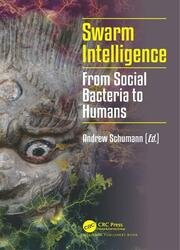Swarm Intelligence: From Social Bacteria to Humans
- Добавил: literator
- Дата: 28-07-2021, 18:43
- Комментариев: 0
 Название: Swarm Intelligence: From Social Bacteria to Humans
Название: Swarm Intelligence: From Social Bacteria to HumansАвтор: Andrew Schumann
Издательство: CRC Press
Год: 2021
Страниц: 191
Язык: английский
Формат: pdf (true)
Размер: 19.9 MB
Recently, in computer science there are developed different multi-agent systems which are inspired by intelligent behaviors of swarms: ants, bees, flocking of sheep (horses), shoaling and schooling of fish, etc. For example, these systems can be represented as groups of robots working together on the same task. So, swarms are regarded as a natural kind of multiagent systems whose members support each other and have a division into different social roles in realizing their joint work. Therefore, swarms give a natural bio-inspired model of artificial multi-agent systems with some social functions.
The notion of swarm intelligence was introduced for describing decentralized and self-organized behaviors of groups of animals. Then this idea was extrapolated to design groups of robots which interact locally to cumulate a collective reaction. Some natural examples of swarms are as follows: ant colonies, bee colonies, fish schooling, bird flocking, horse herding, bacterial colonies, multinucleated giant amoebae Physarum polycephalum, etc. In all these examples, individual agents behave locally with an emergence of their common effect.
An intelligent behavior of swarm individuals is explained by the following biological reactions to attractants and repellents. Attractants are biologically active things, such as food pieces or sex pheromones, which attract individuals of swarm. Repellents are biologically active things, such as predators, which repel individuals of swarm. As a consequence, attractants and repellents stimulate the directed movement of swarms towards and away from the stimulus, respectively.
It is worth noting that a group of people, such as pedestrians, follow some swarm patterns of flocking or schooling. For instance, humans prefer to avoid a person considered by them as a possible predator and if a substantial part of the group in the situation of escape panic (not less than 5%) changes the direction, then the rest follows the new direction, too. Some swarm patterns are observed among human beings under the conditions of their addictive behavior such as the behavior of alcoholics or gamers.
The methodological framework of studying swarm intelligence is represented by unconventional computing, robotics, and cognitive science. In this book we aim to analyze new methodologies involved in studying swarm intelligence. We are going to bring together computer scientists and cognitive scientists dealing with swarm patterns from social bacteria to human beings. This book considers different models of simulating, controlling, and predicting the swarm behavior of different species from social bacteria to humans.
This book contains results of nine researches about swarm intelligence with an emphasis on modeling different reactions of swarms and some ways how these models of reactions can be used in computer science.
Скачать Swarm Intelligence: From Social Bacteria to Humans
Внимание
Уважаемый посетитель, Вы зашли на сайт как незарегистрированный пользователь.
Мы рекомендуем Вам зарегистрироваться либо войти на сайт под своим именем.
Уважаемый посетитель, Вы зашли на сайт как незарегистрированный пользователь.
Мы рекомендуем Вам зарегистрироваться либо войти на сайт под своим именем.
Информация
Посетители, находящиеся в группе Гости, не могут оставлять комментарии к данной публикации.
Посетители, находящиеся в группе Гости, не могут оставлять комментарии к данной публикации.
